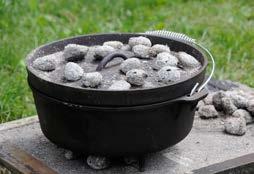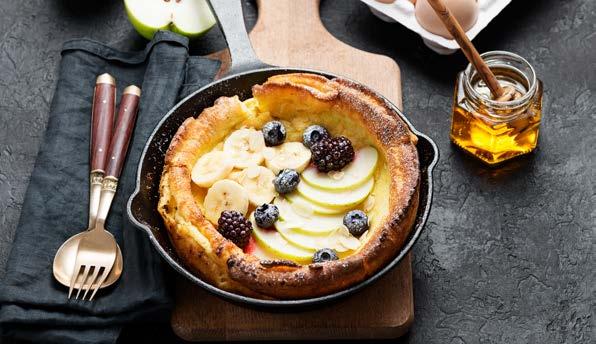
5 minute read
DUTCH OVENS
I'm willing to bet that some of you received a Dutch oven as a gift this holiday season. If so congratulations! You are in for a treat. Nothing beats slicing into a freshly baked loaf of bread that you've just taken off the fire. This article will give you some of the basics of your Dutch oven and also a few recipes that you can practice so you can "WOW" your camping friends. cool and that's it! You've now seasoned
CARING FOR YOUR DUTCH OVEN: SEASONING
First, let's go over a few basics. Cast iron Dutch ovens must be seasoned before they can be used. If you received an aluminum Dutch oven, it does not require seasoning. Seasoning is heated oil that is bonded to the metal through a process called polymerization. This will prevent your Dutch oven from rusting and it forms a non-stick cooking surface.
Although using vegetable oil is preferred, promptly with either a paper towel or a lint
other oils can be used. Whichever oil you choose, you will need to find that oil's smoke point. A chemical reaction occurs at that smoke point, so the oil will bond to your pan. You can reference this article to determine the smoke point of the oil you'd like to use. The article will also tell you if that oil has a neutral flavor or not. To season a new Dutch oven (or any cast iron), scrub the pan with warm, soapy water. Since you are seasoning the pan for the first time, it is ok to use soap. Rinse and dry thoroughly. Secondly, apply a very thin layer of the oil of your choice, inside and out. Lastly, place your Dutch oven upside down in the oven, with either a large baking sheet or foil on the bottom of the oven for easy clean up. Bake at 450° - 500°F (230° - 260°C) for or higher smoke point, adjust the baking temperature. Allow your Dutch oven to your cookware. Note: You can do this on an outdoor grill if you can accurately measure the temperature. This may be preferred because there will be smoke. If you do this in your kitchen, be sure to crack some windows and keep your kitchen exhaust fan on during this process.
CARING FOR YOUR DUTCH OVEN: WASHING
To clean your Dutch oven, you can use a small amount of soap, per Lodge Cast Iron. If needed, use a pan scraper to remove any stuck food. If you’re at the campground, add a few inches of water to the pot and place back on the fire until the water boils. Once it’s cool enough to handle, scrape out any food residue. Dry your Dutch oven one hour. If you are using an oil with a lower
free towel. It’s normal to notice a little bit of black residue on your towel. Because of this, we usually use paper towels to dry cast iron. Lastly, rub a very thin layer of cooking oil over the surface of your Dutch oven and wipe the excess with a paper towel so no oil residue remains. This last step helps in keeping the pan seasoned and in preventing it from rusting.
BAKING IN YOUR DUTCH OVEN

When baking in a Dutch oven over a fire, we recommend to rotate your Dutch oven a quarter turn every 15 minutes to maintain an even temperature and to help eliminate hot spots. If you have coals on the lid, rotate the lid as well, but in the opposite direction. It is also recommended to have more heat on the lid than under the Dutch oven for baking. For example, if you want to make the bread recipe below (in a 10 inch pan) using coals from the fire, you would need roughly 19 briquettes or the equivalent size wood embers on the lid and about 10 briquettes under the Dutch oven in order to bake at roughly 450°F (230°C). Below are a few simple recipes that you can try at home or at the campsite.
DUTCH OVEN BREAD
Here is a simple bread recipe to try. You can make this indoors in your oven or outside on the fire. Here is a link to a quick YouTube video demonstrating how easy this recipe is to make.
INGREDIENTS
3 cups flour 1 teaspoon salt 1/2 teaspoon yeast 1.5 cups warm water Mix the dry ingredients first and then add the water and mix thoroughly. You can mix this completely with your hands which makes it an easy campground recipe. Let rise overnight. Preheat the oven to 450°F (230°C) and bake for 30 minutes covered and 10 minutes uncovered. Remove the bread from the Dutch oven, cover with a towel and let cool for about 10 minutes before slicing.
DUTCH OVEN DUMP CAKE
If your looking for a go-to dessert to make fresh while camping, this should help fit the bill. It includes a few easy to pack ingredients and it's fantastic.
INGREDIENTS
1 package of yellow cake mix 1 can cherry pie filling 1 can crushed pineapple 2 tablespoons butter
For easier cleanup, line the Dutch oven with baking paper as neatly as possible. Dump the cans of fruit into the Dutch oven Dump the cake mix on top. Dot with pieces of butter. Place your Dutch oven on about 7 or 8 briquettes or the equivalent sized wood embers in the campfire. Put the lid on your Dutch oven and place about 14 briquettes or equivalent on top. This will roughly equate to a 350°F (175°C) temperature. Bake for roughly 40 minutes, checking after the first 30 minutes. Cool slightly before serving. You can substitue any fruit of your choice in this recipe. This basic recipe allows for endless variations and this link will help guide you to some other fantastic recipes. If fresh fruit is in season, I recommend experimenting with fresh fruit. Fresh, juicy peaches are amazing in this recipe instead of canned peaches. We like to forage for berries while on hikes. These make for a great topping on the cake as well.
Enjoy!


